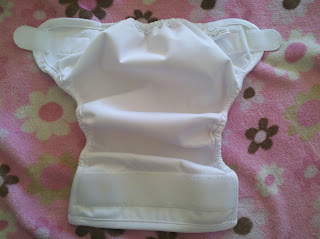Now that you've read the descriptions of the different cloth diapers, I want to show you so it's easier to understand.
Prefold and Cover Cloth Diaper
After you wash your prefold multiple times, it will look textured like the picture above.
This is a Bummis Super Whisper Wrap. It's the water proof cover that you put on the outside of a folded prefold.
One of the many folds you can do with a prefold. This is called a trifold. As you can see, you just lay it in the cover. Other folds you will have to secure it with a snappi, or pins, then put the cover on top. This particular cover has a pocket to hold the prefold in place.
The Bummis Super Whisper Wrap secures with velcro. You can also get covers that close with snaps.
This is a prefold with the traditional safety pins to secure it. A lot of people prefer this style for premature or newborn babies. This sweet little girl is only 5 pounds 12 ounces.
Fitted Cloth Diapers
This is a Growing Green Organic fitted diaper with snap closures. On top of this, you would put a cover. Some mom's don't actually put a cover on when they are at home and changing their baby often. The fitted diaper is not waterproof, so it's recommended to put a cover on top.
\
Green Mountain, Workhorse fitted diaper with snap closures.
This cute little guy has on a fitted diaper that is being held closed by a Snappi, the alternative to the pins.
The cover on top of the fitted diaper.
Pocket Cloth Diapers
This is a Fuzzibunz one size elite pocket diaper.
The Fuzzibunz are shaped more narrow than other brands which helps with the fit. They are a little more of a chore to stuff.
Numbered slotted elastic for both leg openings and the rear/back elastic. Just push the button through the desired slot. This helps a lot with the fit of the diaper.
More Fuzzibunz diapers with a microfiber insert. You can see how it fits on a baby!
Microfiber insert inside the "pocket".
This is a Kawaii one size pocket diaper.
One size Sunbaby pocket diaper, on it's smallest setting.
It has snaps on the side to adjust the size of the leg hole.
Let all the way out on the biggest setting.
This is the leg hole on the biggest setting. As you can see it's much bigger than on the smallest setting, which helps to give you a custom fit.
All in Two cloth diapers (AI2)
This is a Grovia all in two, one size diaper. It has the snaps to adjust the rise of the diaper, and velcro to keep it closed. It comes in snaps as well.
This shows the laundry tab. When you are washing your diapers with velcro, you want to fold it down so it doesn't get stuck on everything it touches.
This is the insert you snap inside of the outer, waterproof layer.
The inside of Grovia AI2's are mesh. It helps the diaper breathe and is still easy to clean.
This is a Trend Lab, one size, all in two diaper. The insert you see on top can come off. You have the option to just remove the soiled insert, instead of the whole diaper
All in One Cloth Diaper
Bumkins one size, all in one diaper (AIO). This diaper has everything attached together. The insert is long, and you fold it into the pocket in the back.
Hybrid Cloth Diaper
Mabu Eco Diaper Hybrid system
From left to right: Outer shell, insert holder, cloth insert, disposable insert.
The holder snaps into the shell, then you can decide whether you want to use a disposable, or cloth insert.
It fastens a lot like a disposable. You can change just the soiled insert. Cons are they are not one size, so you have to buy larger sizes as they grow. If you decide to use disposable inserts, you have additional costs.
Thank you to:
Alicia Smith for providing pictures and explanations of Bummis Super Whisper Wrap, Fuzzibunz pocket diapers, Grovia, and Trend Lap AI2's, and Mabu Eco hybrid diapers.
Laura Castillo for providing pictures and explination of prefold, Growing Green Organic fitted, and Green Mountain Workhorse fitted diapers.
Sian Sheaffer for providing pictures of a fitted and cover.
Andrea Burton for providing pictures of fuzzibunz pocket diapers.
Courtney Eastepp for providing pictures of Kawaii pocket diapers.
Kasey Duffy for providing pictures and explanation of the Bumkins AIO diaper.

















.jpg)
.jpg)



.jpg)
.jpg)














